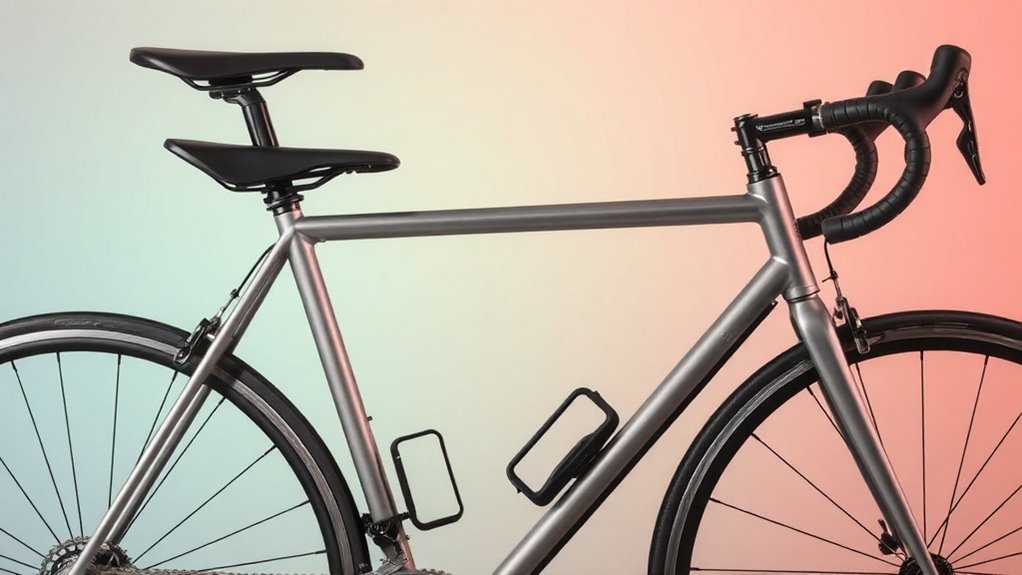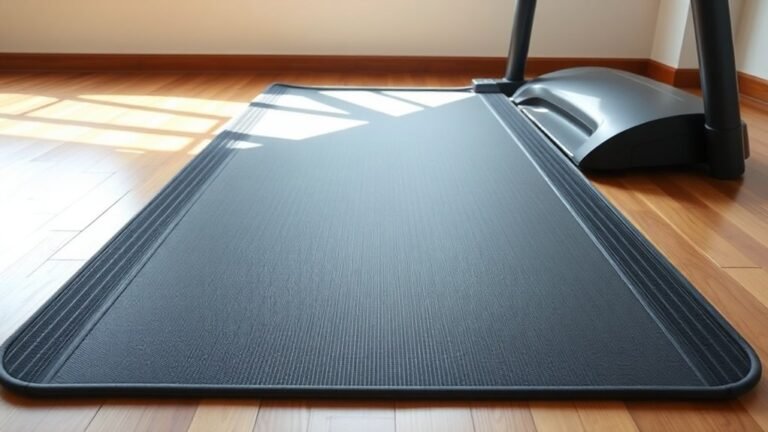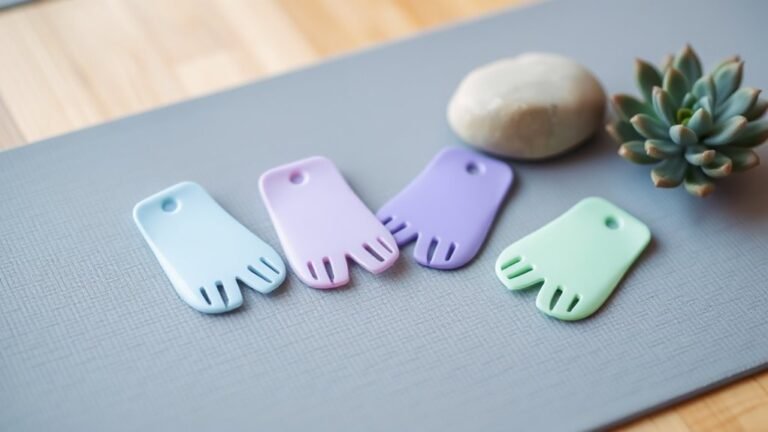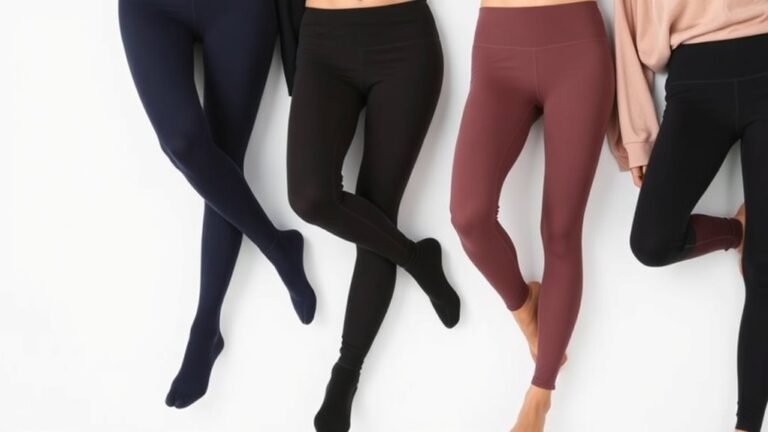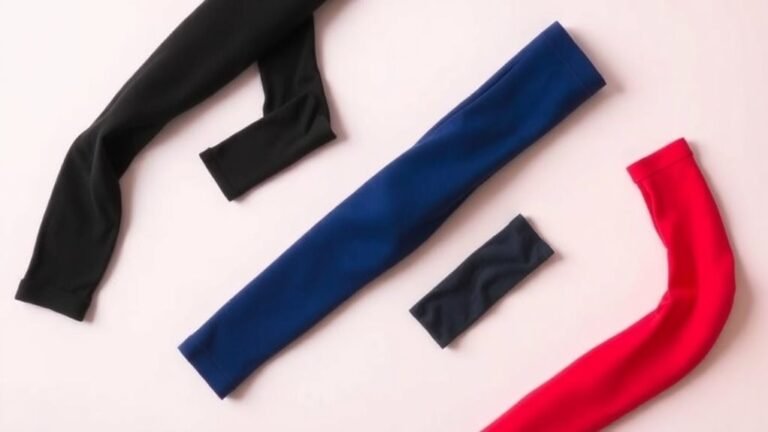10 Best Bluetooth Cadence Sensors for Accurate Cycling Tracking in 2025
For the best Bluetooth cadence sensors in 2025, consider the Magene Speed/Cadence Sensor for a budget-friendly option, or the reliable COOSPO Cadence and Speed Sensor. If you’re after accuracy, the CYCPLUS Cycling Sensor delivers great performance. Additionally, Wahoo’s RPM Sensor offers easy app connectivity. Don’t forget the Garmin Speed and Cadence Sensor bundle for thorough tracking. There’s a lot more to explore about features and options, so stick around to find the perfect fit for your cycling needs.
Key Takeaways
- The Magene Speed/Cadence Sensor offers accurate tracking and is budget-friendly, suitable for performance-focused cyclists.
- COOSPO’s Cadence and Speed Sensor combines functionality with strong durability, making it ideal for budget-conscious users.
- CYCPLUS provides precise measurements with its compact design, perfect for accurate indoor cycling metrics.
- The COOSPO Bluetooth 5.0 ANT+ Sensor is user-friendly and supports dual connectivity, enhancing convenience during rides.
- Wahoo RPM focuses on casual cyclists, offering straightforward installation and reliable performance at an affordable price.
Magene Speed/Cadence Sensor for Cycling
If you’re in search of a reliable yet budget-friendly cycling sensor, the Magene Speed/Cadence Sensor is a fantastic choice for both road and indoor riders. Weighing in at merely 9 grams, this sensor is compatible with Bluetooth and ANT+, providing real-time speed and cadence data to popular apps like Zwift and Strava. Its straightforward installation ensures that it stays securely attached to your bike, so you can focus on your ride.
The sensor boasts an IP66 water resistance rating, making it durable enough to withstand various weather conditions. While it has garnered commendations for its accuracy, a few users have noted occasional connectivity issues that might detract from the overall experience. In any case, the Magene Speed/Cadence Sensor offers a cost-effective way to enhance your cycling performance without making a hefty financial investment.
Best For: Cyclists looking for an affordable and lightweight solution to improve their performance metrics while riding, whether on the road or indoors.
Pros:
- The installation process is straightforward, ensuring a secure fit on a variety of bike mounts.
- It seamlessly integrates with well-known cycling apps like Zwift and Strava for real-time tracking of your metrics.
- An IP66 water resistance rating reinforces its durability under different weather conditions.
Cons:
- A few users have reported intermittent connectivity issues along with sporadic failures during use.
- Some feedback indicates that the sensor’s accuracy may not always be consistent.
- There is mixed feedback regarding the responsiveness of customer service when it’s needed.
COOSPO Cadence and Speed Sensor for Bicycles
The COOSPO Cadence and Speed Sensor is an ideal choice for budget-conscious cyclists looking for dependable performance at an affordable price. This versatile 2-in-1 sensor is equipped with both Bluetooth and ANT+ connectivity, allowing seamless integration with popular cycling applications like Rouvy and Wahoo. With an impressive IP67 waterproof rating and a durable CR2032 battery, users can count on consistent data during their rides.
Installation of the COOSPO sensor is praised for its simplicity, generally taking less than 15 minutes. However, some users have reported encountering difficulty with Bluetooth connectivity, which may be a consideration for those prioritizing this feature. Overall, this sensor offers significant value, evidenced by a solid 4.2-star rating based on over 319 reviews, making it a great option for cyclists eager to enhance their riding experience without overspending.
Best For: Budget-conscious cyclists seeking reliable performance and functionality without overspending.
Pros:
- Compatibility with Bluetooth and ANT+ makes it suitable for use with popular cycling apps like Rouvy and Wahoo.
- It has an IP67 waterproof rating and a long-lasting CR2032 battery, making it durable for outdoor conditions.
- The easy installation process typically takes under 15 minutes.
Cons:
- Some users have encountered Bluetooth connectivity issues when compared to ANT+ pairing.
- There are mixed reviews regarding the responsiveness of customer service and the overall reliability of the product.
- It may not be the best option for indoor spinning bikes or for those who prioritize Bluetooth connectivity.
CYCPLUS Cycling Speed and Cadence Sensor
The CYCPLUS Cycling Speed and Cadence Sensor is a top-notch option for cyclists in search of a trustworthy and budget-friendly tracking device. With dimensions of only 38mm × 29.5mm and a light weight of just 9.2g, it significantly reduces any extra load on your bike during rides. Additionally, the sensor features both Bluetooth and ANT+ support, making it easy to connect with a variety of cycling computers and applications.
One standout feature is its dual-mode functionality, which enables users to switch seamlessly between measuring speed and cadence. The device boasts an impressive battery life of 300 hours while in use, allowing for extended rides without frequent charging interruptions. However, a few users have noted minor issues with the sleep mode, yet the majority commend its accuracy and straightforward installation process.
Best For: Cyclists seeking an affordable, accurate, and easy-to-install speed and cadence tracking solution.
Pros:
- The sensor offers Bluetooth and ANT+ compatibility, enhancing its usability with numerous cycling devices.
- Its long battery life of 300 hours during active use minimizes the need for constant charging breaks.
- The lightweight and compact design ensures that riding performance remains unaffected.
Cons:
- Some users have reported challenges with sleep mode activation that may hinder usability.
- There can be occasional inconsistencies in tracking while riding, which may affect data accuracy.
- The installation process might require double-sided tape, which some may find less durable over time.
COOSPO Bluetooth 5.0 ANT+ Bike Cadence Speed Sensor
For cyclists in search of a dependable way to monitor their cadence and speed, the COOSPO Bluetooth 5.0 ANT+ Bike Cadence Speed Sensor is an excellent choice. This device boasts compatibility with both Bluetooth 5.0 and ANT+, ensuring seamless connectivity. It delivers cycling speed measurements with a commendable precision of ±0.1 km/h and cadence accuracy of ±1 RPM, providing essential real-time data to help you enhance your performance.
The sensor’s design includes an impressive IP67 waterproof rating, which gives you the confidence to ride in various weather conditions without worry. Installation is straightforward and does not involve the use of magnets, making it compatible with most bike frame sizes. Moreover, it features a robust 300-hour battery life, allowing you to focus more on your cycling journey rather than frequent recharging.
This device is particularly well-suited for budget-conscious cyclists who want an accurate and user-friendly solution for monitoring their speed and cadence effectively. It stands out for its ease of installation, ensuring that anyone can set it up without hassle. With the real-time data it provides, cyclists can track their performance more closely and make adjustments as necessary.
However, there are a few drawbacks to consider. Some users have reported concerns regarding the durability of the silicone strap, raising questions about long-term resilience. Additionally, while customer support has been noted as responsive, there have been occasional reports of strap failures. Lastly, compatibility may be limited with certain older bike computers not explicitly mentioned, which could affect some users’ experiences.
Wahoo RPM Cycling Cadence Sensor for Bikes
Looking for a dependable method to track your cycling cadence? The Wahoo RPM Cycling Cadence Sensor is an excellent choice. It provides real-time cadence and speed measurements while effortlessly connecting to popular apps like Wahoo SYSTM, Zwift, and Peloton using Bluetooth technology.
Thanks to its dual-band functionality, this sensor pairs easily with both smart devices and bike computers. Installation is straightforward, featuring a sleek, magnet-less design that simplifies the setup process. Many users appreciate the affordability and ease of use of the product, often giving it a commendable 4.4-star rating.
While some users have mentioned experiencing minor delays in readings, the overall accuracy of the sensor meets the needs of casual cyclists. It serves as a fantastic tool for enhancing your cycling experience without breaking the bank.
Best For: Casual cyclists seeking an economical and user-friendly cadence sensor to monitor their performance on the bike.
Pros:
- Provides seamless connectivity with popular cycling apps through Bluetooth and ANT+.
- The innovative magnet-less design ensures easy mounting and installation.
- High customer satisfaction is reflected in its 4.4 out of 5 stars rating from more than 12,500 reviews.
Cons:
- A few users have reported minor delays in cadence readings during use.
- Compatibility issues may occur with third-party apps, especially for Android users on Peloton.
- There is a call for enhanced battery longevity and broader app integration to track various fitness metrics more effectively.
Magene Outdoor/Indoor Speed/Cadence Sensor for Cycling
The Magene Outdoor/Indoor Speed/Cadence Sensor is a perfect pick for cyclists who want a dependable and lightweight tool to boost their performance tracking. With a mere weight of 9 grams, this sensor supports Bluetooth and ANT+ connectivity, allowing it to pair effortlessly with popular apps such as Onelap and Zwift. Cyclists have the option to set it up to monitor either speed or cadence, but keep in mind that two sensors are required for tracking both metrics simultaneously.
Installation of the Magene sensor is straightforward, and its water-resistant design (IP66) makes it suitable for outdoor environments. While many users appreciate its accuracy and value, some have experienced connectivity challenges. To ensure optimal functionality, it’s advisable to replace the battery after the initial setup to prevent any unforeseen issues.
The Magene Speed/Cadence Sensor is ideal for cyclists seeking a lightweight and efficient solution for accurate workout measurement.
Pros:
- Easy to install with a secure grip on mounts.
- Provides precise performance tracking that enhances workout quality.
- Compatible with popular cycling applications such as Wahoo Fitness and Strava.
Cons:
- Some users have mentioned occasional connectivity problems and instances of the sensor being unresponsive.
- Two sensors are needed for the simultaneous tracking of speed and cadence.
- Concerns regarding battery reliability could lead to the need for premature replacement post-setup.
MOOFIT Speed/Cadence Sensor for Cycling
The MOOFIT Speed/Cadence Sensor is a fantastic choice for budget-conscious cyclists looking to enhance their riding experience. It features a dual-protocol design that utilizes both ANT+ and Bluetooth technology, which allows it to be compatible with a variety of devices. Weighing only 8 grams, this compact sensor delivers accurate cadence measurements within a ±3% margin, and it functions effectively across a range of 60 to 120 RPM. Additionally, its IP67 waterproof rating ensures that it performs reliably, regardless of the weather conditions.
With a replaceable CR2032 battery, the sensor provides up to 300 hours of usage, making it a practical option for those who cycle frequently. Installation is designed to be quick and easy; there are no magnets required, and it fits seamlessly onto the bike’s crank arm or hub. This ease of installation allows cyclists to set up the sensor without the hassle often associated with similar products.
Best For: This sensor is ideal for budget-conscious cyclists seeking an accurate, user-friendly speed and cadence solution that is compatible with multiple devices.
Pros:
- The dual-protocol design supports both ANT+ and Bluetooth connectivity, ensuring broad compatibility with various bikes and fitness machines.
- Its IP67 waterproof rating guarantees reliable functionality in different weather conditions, providing peace of mind while riding.
- Weighing just 8 grams, this lightweight sensor offers straightforward installation, enhancing user convenience.
Cons:
- Users may find it inconvenient that mode switching requires reinstalling the battery, limiting quick adjustments.
- Some users have experienced reliability issues with mode switching, which may affect overall satisfaction.
- The accuracy margin of ±3% might not meet the demands of highly competitive cyclists who require precise measurements.
moofit Cadence Speed Sensor for Cycling Spin Bike
For indoor cycling enthusiasts looking for a dependable and user-friendly way to monitor their performance, the moofit Cadence Speed Sensor is an excellent choice due to its Bluetooth and ANT+ compatibility. Weighing only 9 grams, this compact and waterproof device easily attaches to your bike’s crank arm without the need for magnets. It provides real-time cadence data that is accessible on various bike computers and fitness apps, significantly enhancing your indoor training experience.
Customers have praised the accuracy of the moofit sensor, but some have experienced disconnection issues and noted that its mounting setup may not be as sturdy as that of competing products. Despite these drawbacks, the sensor comes with a one-year warranty, making it a cost-effective solution for those looking to boost their cycling performance. Overall, it presents a good balance of functionality and price.
Best For: Those who engage in indoor cycling and are in search of an economical and straightforward cadence sensor that provides accurate performance tracking.
Pros:
- The installation process is straightforward, as it attaches directly to the crank arm without magnets.
- It offers real-time data tracking through Bluetooth and ANT+ compatibility with a variety of fitness applications.
- Its compact and waterproof design makes it suitable for the indoor cycling environment.
Cons:
- Users have reported occasional disconnection issues and inconsistent speed readings.
- The mounting setup is less robust compared to competitors, which may impact stability.
- There may be limitations in customer support and the warranty claims process is unclear.
COOSPO Cadence & Speed Sensor for Cycling
If you’re seeking a dependable solution to monitor your cycling performance, the COOSPO Cadence & Speed Sensor is a great choice. Featuring both Bluetooth and ANT+ connectivity, this sensor seamlessly integrates with a variety of fitness apps, including popular options like Zwift and Peloton. Weighing in at a mere 9.5 grams, it won’t add any noticeable weight to your bike, and with an impressive battery life of 500 hours, you can enjoy extended rides without any interruptions.
The sensor allows for a convenient switch between cadence and speed modes, though keep in mind that this requires a battery change. While many users commend the device for its accuracy and simplicity, some have noted minor durability concerns regarding the mounting bands. Overall, it presents excellent value for cyclists looking to keep track of their essential metrics.
Best For: This sensor is ideally suited for cyclists who need a lightweight and adaptable device to monitor both cadence and speed while using various fitness applications.
Pros:
- The sensor is user-friendly and connects reliably to numerous apps, such as Zwift and Peloton.
- With its long-lasting battery of 500 hours, you can ride without worrying about your sensor dying mid-session.
- Its lightweight design of just 9.5 grams ensures that it won’t interfere with your biking experience.
Cons:
- Some users have indicated durability problems with the mounting bands, which may need attention.
- Switching between cadence and speed modes necessitates a battery replacement.
- There have been reports of inconsistent data updates and difficulties in pairing with certain apps, such as Strava.
Garmin Speed Sensor 2 and Cadence Sensor 2 Bundle
The Garmin Speed Sensor 2 and Cadence Sensor 2 Bundle is an outstanding selection for cyclists who prioritize simplicity and efficiency in their training tools. These wireless sensors are designed for easy attachment, removing the hassle of magnets and exposed components. This feature also makes transitioning between bikes effortless and efficient.
The Speed Sensor 2 is equipped with self-calibrating technology that ensures precise tracking of speed and distance, even when used without a head unit. Meanwhile, the Cadence Sensor 2 is focused on measuring your pedal strokes per minute, aiding in the optimization of your training sessions. Together, they provide a significant enhancement to your overall cycling experience.
Best For: Cyclists looking for a hassle-free, wireless solution to keep track of both speed and cadence during their rides.
Pros:
- The wireless design removes the need for magnets, making the installation process and bike transitions seamless.
- The self-calibrating feature of the Speed Sensor 2 guarantees accurate speed and distance tracking without depending on a head unit.
- With high customer ratings, users commend the quick connectivity and real-time performance monitoring.
Cons:
- A few customers have mentioned issues regarding the battery lid, which can impact usability.
- Some reviews have pointed out that the product may arrive with dead batteries.
- There could be warranty and support challenges if battery-related problems are not addressed quickly.
Factors to Consider When Choosing Bluetooth Cadence Sensors
When you’re picking a Bluetooth cadence sensor, it’s important to reflect on compatibility with your existing devices. You’ll also want to regard how easy it is to install and whether it provides accurate measurements. Don’t forget to check the battery life and waterproof rating to confirm it meets your cycling needs.
Compatibility With Devices
Selecting the right Bluetooth cadence sensor can significantly improve your cycling experience, making device compatibility a critical consideration. It’s important to choose a sensor that supports both Bluetooth and ANT+ connectivity. This dual support will ensure compatibility with a wide range of devices and popular fitness applications like Zwift, Wahoo, and Peloton.
When looking for a cadence sensor, take note of the connection limits. Some sensors can only maintain a single Bluetooth connection, while ANT+ technology allows for multiple devices to connect at the same time. This flexibility can be a key factor depending on how you plan to use the sensor with other devices.
Additionally, make sure the sensor’s mounting type is compatible with your bike’s setup. Certain sensors may require specific hardware or positioning, so confirming this ahead of time is beneficial. Lastly, it’s wise to review user feedback on app pairing and device connectivity to identify any issues that might occur during the setup process. This will help ensure a seamless integration into your cycling routine.
Installation Ease
When choosing a Bluetooth cadence sensor, it’s important to consider how easy it is to install. Many sensors allow for quick setups, often taking less than 15 minutes. Tools like zip ties or adhesive mounts can simplify the process, and some models even eliminate the need for magnets, making installation easier for those who may not be familiar with bike mechanics.
Clear installation guides can be a significant advantage, as not all sensors come with detailed instructions. This lack of clarity can sometimes lead to confusion during the setup process. Accurate positioning of the sensor is vital for ensuring proper readings, so it’s essential to adhere to alignment guidelines provided by the manufacturer.
In addition to positioning, ensuring that the sensor is securely mounted is crucial. User feedback frequently indicates that using extra zip ties can enhance stability and help maintain reliable data capture. A straightforward installation can significantly reduce setup time, allowing you to hit the road and enjoy your ride sooner.
Measurement Accuracy
After installing your cadence sensor, it’s crucial to ensure measurement accuracy, which plays a vital role in enhancing your cycling performance. Accuracy levels can differ significantly, with many sensors delivering a precision rate of ±1 RPM for cadence and ±0.1 km/h for speed. It’s important to evaluate how well these sensors perform across varying conditions, as some may perform admirably on flat terrain but face challenges on inclines or during adverse weather.
Another factor to consider is the calibration process, which can differ among sensor models. Some sensors require manual calibration, while others have the capability to adjust automatically. Additionally, proper alignment during installation is essential; misaligned sensors often produce inaccurate readings that can hinder your performance tracking.
Finally, opt for a sensor that provides real-time data without delay. Having immediate performance insights during rigorous rides is essential for making quick adjustments and optimizing your cycling experience. The choice of sensor can significantly impact how accurately you can gauge your progress and adapt to changing riding conditions.
Battery Life
When selecting a Bluetooth cadence sensor, battery life is an important consideration that can significantly affect your overall cycling experience. There can be considerable differences in battery longevity, with some models providing up to 500 hours of use, while others may last around 300 hours or even less. It’s essential to research these specifications to find a sensor that aligns with your cycling habits.
Many cadence sensors utilize replaceable batteries, such as the CR2032 coin cell, which makes it convenient to change batteries when necessary. Additionally, certain models are equipped with a sleep mode feature that activates after periods of inactivity, helping to conserve energy. This feature can extend the overall battery life, ensuring your sensor remains operational longer between changes.
The reliability of the battery can directly affect the performance of the sensor, so you might want to consider replacing the original battery for improved consistency and longevity. Furthermore, various power management systems employed by different sensors can also play a role in determining battery life. Taking these factors into account will help you choose a cadence sensor that best meets your riding preferences.
Waterproof Rating
When you’re considering Bluetooth cadence sensors, one crucial aspect to examine is the waterproof rating. This rating indicates how effectively the sensor can endure exposure to water in various situations. Common ratings you might encounter include IP67 and IP66.
An IP67 rating signifies that the device is capable of withstanding immersion in water up to 1 meter for 30 minutes, making it ideal for outdoor cycling. Conversely, sensors with an IP66 rating are designed to resist powerful water jets while remaining dust-tight, which enhances their durability in wet or muddy conditions.
A higher waterproof rating can significantly prolong the life of your sensor, helping to prevent damage from rain, splashes, or sweat during rigorous rides. This feature is particularly vital for cyclists who venture out in unpredictable weather or humid environments.
Connectivity Options
Waterproof ratings are certainly essential, but the way your cadence sensor connects to your devices is just as vital. Most Bluetooth cadence sensors only support single-device connectivity, which can limit your usage to one app or device at a time. If you wish to monitor data across various devices, it’s worth looking into sensors that use ANT+ technology, as these allow for multiple simultaneous connections.
It’s important to ensure that your selected sensor is compatible with your cycling app, since not all sensors integrate smoothly with every option available. Some sensors incorporate dual-band technology, providing both Bluetooth and ANT+ connections for enhanced flexibility in usage. Lastly, keep in mind that the setup process can differ significantly; many sensors require you to pair them through the app, so understanding your sensor’s pairing method is key to having a seamless experience.
Price and Value
Price is a crucial consideration when selecting a Bluetooth cadence sensor, as it significantly impacts your overall cycling experience. Budget-friendly models typically start around $30, while premium options can surpass $100. It’s important to evaluate which features are most important to you to ensure you get the best value for your investment.
Long battery life, ranging from 300 to 500 hours, compatibility with various apps, and accurate readings can greatly enhance your cycling performance. Additionally, sensors that come with extra functionalities, such as dual-mode support or ANT+ connectivity, often warrant a higher price tag. Remember to also assess the reliability of the product and the warranty options available, as these can have a significant effect on your long-term satisfaction and overall cost-effectiveness.
Ultimately, aim to select a cadence sensor that strikes the right balance between features, durability, and price to meet your specific cycling needs. By considering these factors carefully, you can make an informed decision that will enhance your cycling experience without breaking the bank.
Questions
Are Bluetooth Cadence Sensors Waterproof for Outdoor Cycling?
Yes, many Bluetooth cadence sensors are waterproof or water-resistant, making them suitable for outdoor cycling. You should check the specifications to confirm yours can withstand rain and outdoor conditions without affecting its performance.
How Do I Calibrate My Bluetooth Cadence Sensor?
To calibrate your Bluetooth cadence sensor, you’ll need to follow the manufacturer’s instructions. Typically, this involves spinning your pedals at specific speeds and ensuring your bike computer recognizes the data accurately. Check for any firmware updates too.
Can I Use Multiple Cadence Sensors With One Cycling App?
Yes, you can use multiple cadence sensors with one cycling app, but it depends on the app’s compatibility. Check the app settings to see if it supports multiple devices simultaneously. Happy cycling!
What Is the Battery Life of Most Bluetooth Cadence Sensors?
Most Bluetooth cadence sensors boast a battery life of 200 hours—long enough to ride to the moon and back! Yet, you’ll still find yourself scrambling for extra batteries during your next big ride.
Do Bluetooth Cadence Sensors Work With Indoor Cycling Bikes?
Yes, Bluetooth cadence sensors work with indoor cycling bikes. They easily connect via Bluetooth, allowing you to monitor your cadence accurately. Just verify your bike is compatible, and you’re good to go! Enjoy your ride!
Conclusion
In today’s cycling world, having the right gear can make all the difference. Did you know that cyclists who track their cadence can improve their speed by over 10%? By choosing a reliable Bluetooth cadence sensor from our top picks, you can enhance your cycling experience and monitor your performance effectively. Whether you’re a casual rider or a serious athlete, investing in one of these sensors will help you reach your cycling goals while enjoying every ride.

